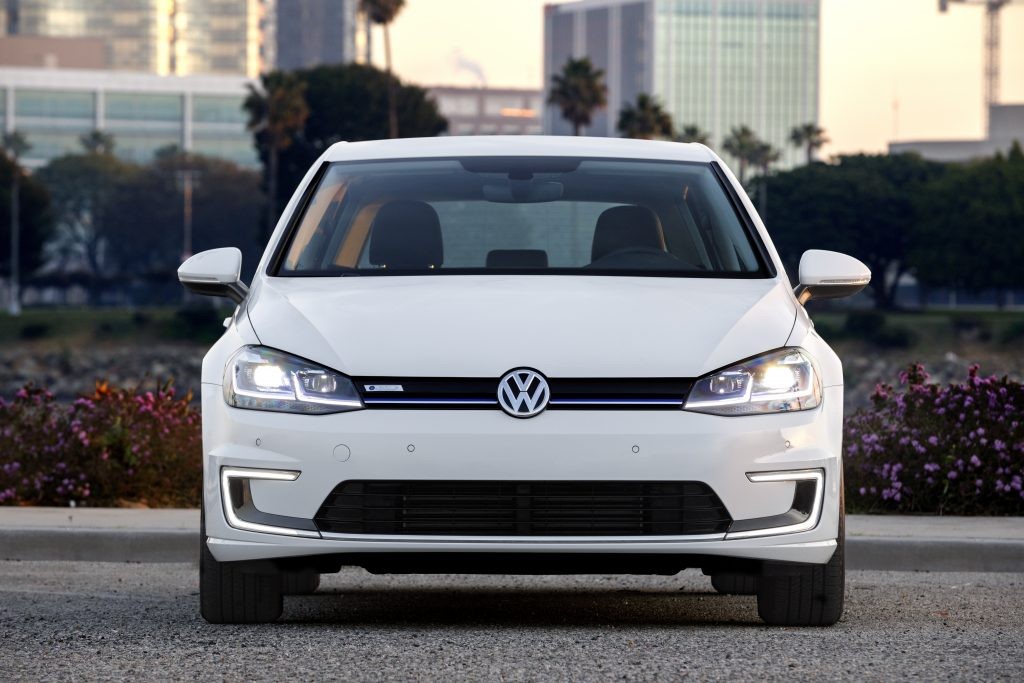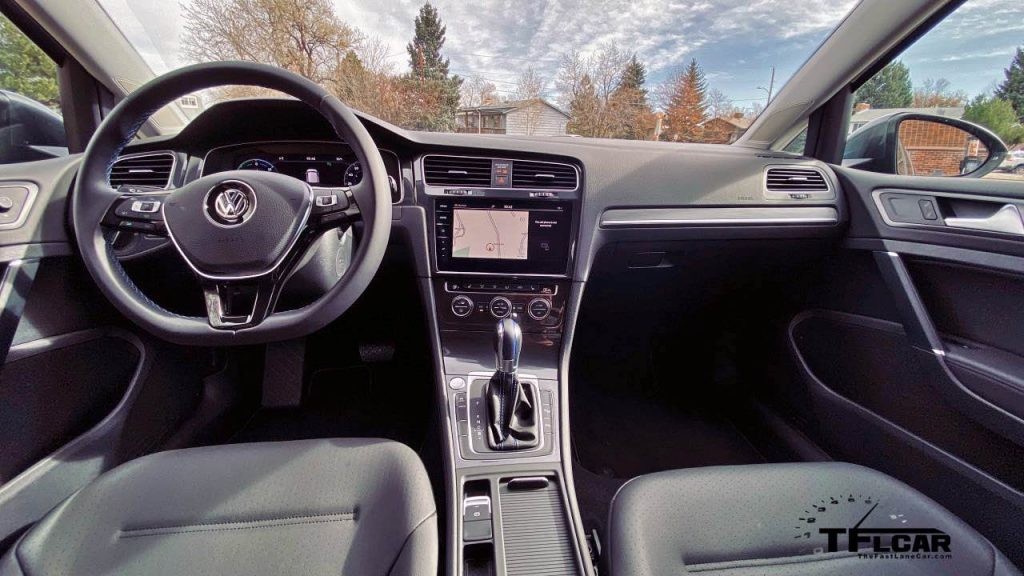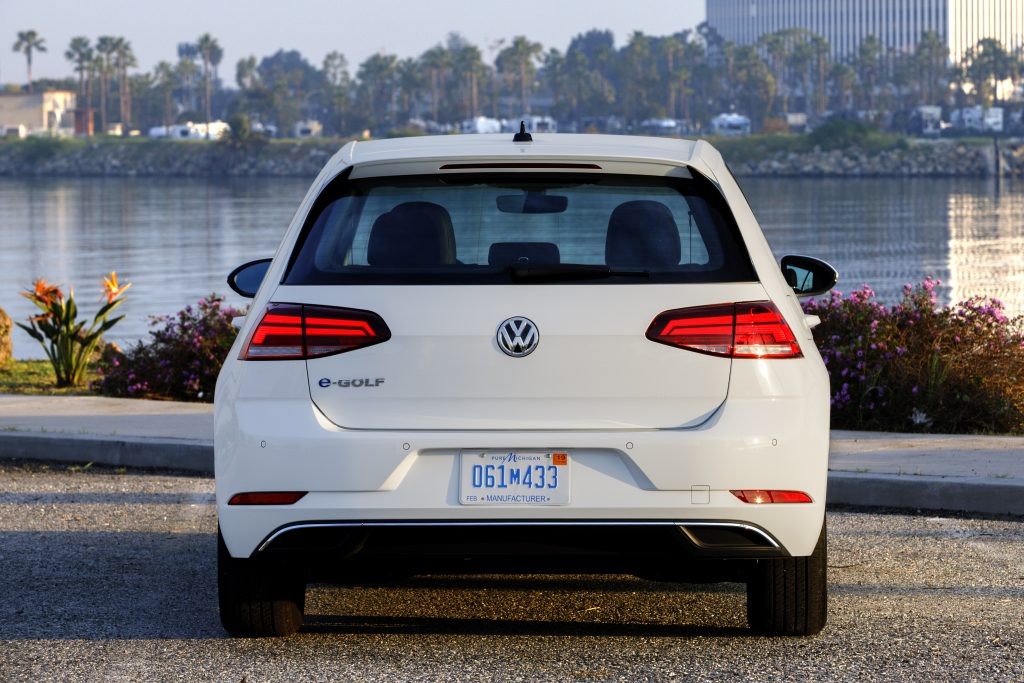As a content creator for cardiagnosticnearme.com and a seasoned auto repair expert, I recently had the chance to spend a week behind the wheel of the Volkswagen e-Golf. Like many VW enthusiasts, I’m a big fan of the GTI, my personal Mark 6 GTI with DSG transmission being a testament to that. Having clocked 65,000 miles in it, I still believe it’s the benchmark for a versatile, sporty car that’s equally at home carving through canyons or tackling the daily commute. So, when presented with the e-Golf, I was admittedly curious but skeptical: could an electric Golf truly win me over from my beloved GTI?
My test vehicle was an e-Golf SEL Premium, carrying a sticker price of $39,790. Stepping inside, the cabin felt immediately familiar. The seating position, dashboard layout, and the flat-bottomed, leather-wrapped steering wheel echoed my GTI. Subtle blue accents and the distinctly non-sporty wheels were the main visual cues differentiating it from a standard Golf. After a week and 260 miles in this electric variant, I uncovered some surprising highs and lows.
 VW e-Golf front view parked on a street
VW e-Golf front view parked on a street
Initial Range and Charging Experience
Being accustomed to EVs thanks to my wife’s Chrysler Pacifica Hybrid, the first step was plugging the e-Golf into my home 240V charger. By morning, the 38.5 kWh battery was fully charged, displaying a projected range of 131 miles – slightly exceeding VW’s official 125-mile estimate.
Over the next few days, the e-Golf showcased its efficiency. Driving around suburban Denver, I focused on maximizing range. Engaging the most aggressive regenerative braking mode (‘B’ setting) and Eco+ Mode (which limits climate control and acceleration, capping speed at 56 mph), I achieved impressive results. After about 100 miles of mindful driving, the estimated range climbed to 175 miles. This was a notable improvement and highlighted the e-Golf’s potential for efficient driving in optimal conditions.
Adding to the positive experience was the classic VW chassis feel. Despite the 701-lbs battery pack positioned beneath the seats, bringing the e-Golf’s weight to 3,459 pounds (slightly heavier than my GTI), the ride remained firm and composed.
However, this range-focused driving came with caveats. Like most EVs, the e-Golf encouraged “range gaming,” prioritizing efficiency over spirited driving. The desire to push the car to its limits, as I naturally do with my GTI, was absent. Furthermore, the test week benefited from mild weather, with temperatures consistently above freezing and daytime highs in the 60s – ideal conditions for EV range performance.
 VW e-Golf side view charging at a charging station
VW e-Golf side view charging at a charging station
Cold Weather Range Impact: A Reality Check
The range-extending success was short-lived as winter weather arrived. Despite a displayed range exceeding 100 miles after a full charge, I proceeded with a long-range test, a 45-mile trip to my kid’s volleyball practice. This route involved a significant elevation gain and navigating through freeway construction during rush hour. Adding to the challenge, temperatures plummeted to 28 degrees with freezing drizzle and rain.
Upon departure, the e-Golf indicated a 145-mile range. However, the journey to practice, lasting nearly two hours due to heavy traffic and accidents, drastically impacted the range. By the time I arrived, the remaining range had plummeted to just 60 miles. This substantial range loss was attributed to stop-and-go traffic, sporadic heater and defroster use (which instantly consumed significant range), and the constant use of windshield wipers.
The return trip presented a further challenge. The interstate was closed, forcing a 50-mile detour on a snowy two-lane road with only 60 miles of indicated range remaining. To conserve battery, we minimized heater use, relying on heated seats and extra layers of clothing, making for a less than comfortable drive. While the mostly downhill route did recover about 10 miles of range, we arrived home with a mere 20 miles remaining, highlighting the significant range reduction in cold and challenging driving conditions.
 VW e-Golf driving in snowy conditions
VW e-Golf driving in snowy conditions
e-Golf vs. GTI: Performance and Driving Dynamics
Comparing the e-Golf to the GTI reveals distinct strengths and weaknesses.
e-Golf Advantages over GTI:
- Instant Torque: In ‘Normal’ mode, the e-Golf delivers immediate torque, surpassing the GTI’s initial turbo lag. The 214-lb. ft of torque is genuinely addictive and even exceeds the GTI’s output, providing brisk acceleration from a standstill. However, once the GTI’s turbocharger spools up, it quickly outpaces the e-Golf in outright acceleration.
Areas for e-Golf Improvement:
- Wheels and Tires: Upgrading to performance tires and wheels would significantly enhance handling and steering feel. While this might reduce range by approximately 10% (as noted by e-Golf owners who have made this modification), the improvement in driving dynamics would be substantial.
- GTI Front Seats: Returning to my GTI after the e-Golf, the aggressively bolstered seats were a reminder of their contribution to the GTI’s sporty feel. Swapping GTI seats into the e-Golf, while not impacting performance figures, would enhance driver engagement, particularly during cornering.
- Extended Range Battery: A battery pack offering a minimum 200-mile real-world range would alleviate range anxiety and significantly improve the e-Golf’s practicality, especially for drivers in colder climates or those with longer commutes.
Despite its limitations, the e-Golf demonstrated its capability by completing the Loveland Trials, a challenging EV test, albeit with some range management strategies.
 VW e-Golf rear view on a paved road
VW e-Golf rear view on a paved road
Conclusion: e-Golf or GTI?
In ideal conditions and for shorter commutes, the VW e-Golf shines as a refined and efficient electric vehicle. However, when faced with challenging weather, mountainous terrain, or longer journeys exceeding approximately 90 miles, range anxiety becomes a significant factor. For drivers primarily operating within a 35-mile radius of home and with predictable climates, the e-Golf is a compelling daily driver option.
However, for those like myself who regularly undertake longer drives and encounter diverse conditions, the GTI remains the more practical choice. While the e-Golf offers a glimpse into an electric future for the Golf, it’s not yet a direct replacement for the all-around versatility and range confidence of the GTI. For now, I’ll be keeping my GTI keys, but I appreciate Volkswagen for the e-Golf experience and look forward to future advancements in EV technology.
